|
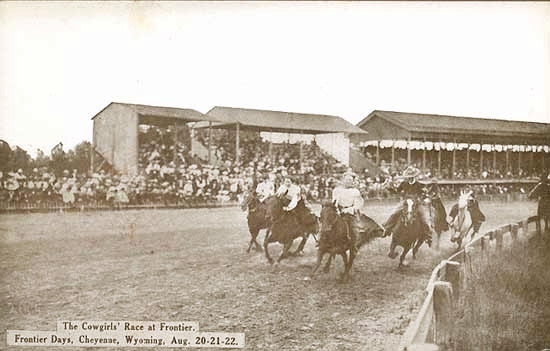
Cowgirl Race, 1908.
Woman have participated in the Frontier Day celebration since at least 1904 when
Bertha Kaepernick gave an impromptu exhibition of bronc riding. Miss Kaepernick grew up on her father's ranch
near Atwood, Colorado, south of Sterling. The following year, 1905, Miss Kaepernick gave another
exhibition at Freontier Day. Additionally, that year several races featured women.
By 1909,
Miss Kaeprnick appeared in the Miller Brothers 101 show under the name "Bertha Ross." That year,
a cowboy then originally from Iowa, Adelbert "Dell" Blancett, was bulldogging in the show. Dell Blancett was already well known and
was the World Champion bulldogger. He had replaced
Will Pickett for the 1909 season. Pickett had been severerly injured whilst attempting to wrestle a bullfighting bull in Mexico City. The bull, named Frijoli Chiquita, "Little Beans,"
was one of the meanest bulls in all of Mexico. The contest was as a result of a 5,000 peso bet with the winner also to
receive the entire gate. The wager made by
Joe Miller was that Pickett could stay in the area with the bull for 15 minutes and grapple the bull for
five minutes. The crowd of 25,000,including President Diaz, fully expected to see Pickett killed. If Pickett
was killed, Miller would recieve only Pickett's funeral expenses. Pickett stayed in the arena with
the bull for 38 1/2 minutes and held on to Frijoli Chiguita for a total of 7 1/2 minutes. Although Miller won the
bet and received the $5,000 pesos and the gate estimated at 48,000 pesos, Pickett was severally injured included three broken ribs. The crowd was unhappy. They threw
oranges, seat cushions, stones and other objects at Pickett. The broken ribs were sustained as a result of a
beer bottle. Pickett was thus out of action for 1909. For the story of Pickett and the bullfight see
Haynes, Bailey C.: "Bill Pickett, Bulldogger: The Biography of a Black Cowboy," University of Oklahoma, 1977.
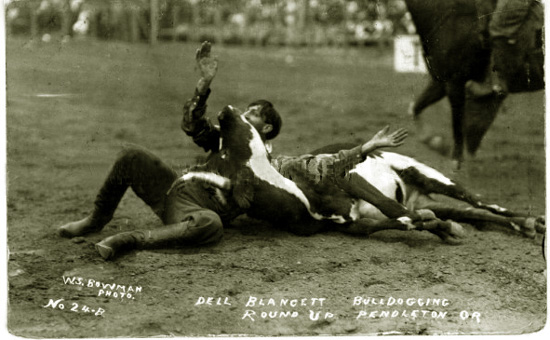
Dell Blancett, Pendleton, 1909.
In August, 1909, Dell and Bertha left the show and were married in Detroit, Michigan. In 1910,
they did stunt riding and were extras for Bison Films.
By 1911 and 1912, the Blancetts were on the Rodeo Circuit including appearing at Pendleton and Calgary.
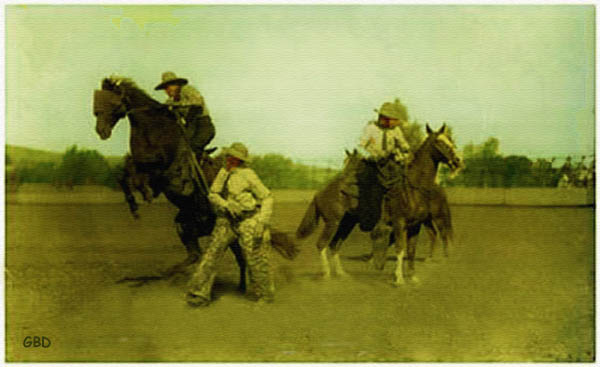
Dell Blancett, Calgary, 1912.
The same year, 1912, Bud Atkinson, previously
associated with the late Dick Stanley, organized Bud Atkinson's American Circus and Wild West in order to
tour eastern Australia. The troupe included 200 performers, including 58 wild west performers, colonials, Cossacks, Arabs, and Indians.
The show had 100 horses. Among those who signed on with Atkinson were the Blancetts.
Advertisments in the Sidney Morning Herald headlined performers including "Joe Bailey" the horse with a
High School Education," Tex McLeod champion roper of the world, and Dell Blancett champion steer bulldogger.
Atkinson advertised that he would give anyone who brought a horse to the show that his boys could not
ride £20. It cost Atkinson £8,300 to organize the
show and transport it to Australia. By December 14, The show had opened in Sidney's
Moore Park in time for Boxing Day on the 26th. By March 1913, the show was in Melbourne. In April, the show was back in Sidney. Unfortunately, Atkinson had forgotten
that in Australia the distances are great and the population was small. He also forgot that the railroads
were constructed on different guages. New South Wales was constructed on a standard guage of 4ft, 8 1/2 in. while
Victoria State was constructed on a broad "Irish" guage of 5 ft. 3 in. Thus, moving the show from
Sidney to Melbourne by rail was impractical. The show and its wagons had to be pulled by the horses overland.
Back in Sidney, the show was broken up and sold at auction, leaving the performers without funds to get home. An advance man
for the show, Murray Pennock, read about the closing in a newspaper. When Pennock attempted to get back to Melbourne, he discovered that
his rail pass had been revoked. A kindly railroad agent who had previously worked in the United States honored it anyway.
A benefit show was put on in Sidney to raise funds for the stranded Americans. It raised $1800 which got the otherwise
stranded Americans home. Pennock along with Atkinson's contracting agent
H. S. Rowe joined the Irwin Bros. Wild West Show where again the employment proved to be short
lived.
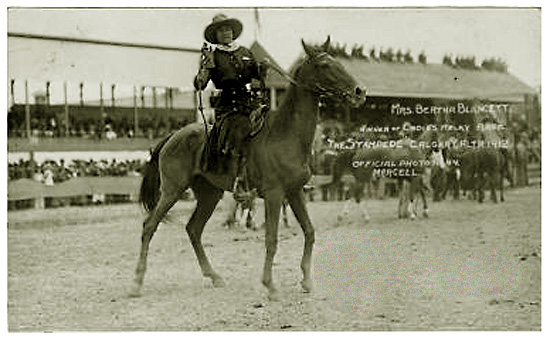
Bertha Blancett, Calgary, 1912.
Back in the United States, the Blancetts were back on the Rodeo circuit.
In 1914, Bertha won the cowgirl's bucking contest at Pendleton. The two appeared at the Calgary Stampede.
Her husband Dell was a World Champion bulldogger. Bertha rode as his hazer. A "hazer" is a second rider who
task is to keep the steer running in a straight line without touching or assisting the
wrestler. With the war breaking out in Europe, Dell was one of the organizers of a voluntary company, the
Oregon Troop D Field Artillary. Dell was, however, then rejected for service because of
rheumatism. Telling his mates at Troop D, that he would be across "the pond" before them, Dell headed to
Canada and enlisted.
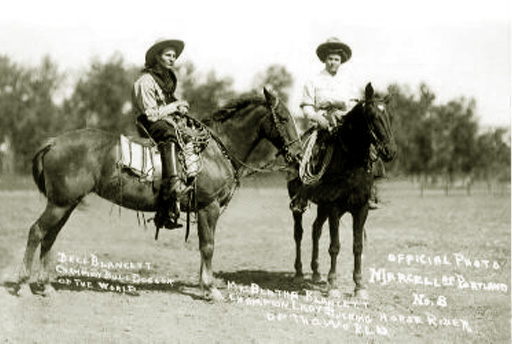
Dell and Bertha Blancett, Pendleton, 1914.
Dell was assigned to the A Squadron of the Lord Strathcona's Horse (Royal Canadian). The unit was (and remains) one of the
most elite of Canadian Cavalry units. It had been formed by the Honourable Donald Alexander Smith,
later the 1st Baron Strathcona, as a privately organized cavalry unit during the Boer War. It was comprised of
cowboys and members of the Northwest Mounted Police. On April 11, 1918, the United Press sent out over its wire services:
Pendleton, Ore., April 11.--Even cowboys and cowgirls disagree on the war.
Charging desertion, Bertha Blancett, the west's best known cowgirl and repeated winner of the women's world's
championship for broncho riding, today has a divorce suit on file against Dell Blancett, star roper and bulldogger, now with the
Canadian forces.
The Blancetts, who own large ranch properties, have appeared all over the west in Round-up and Frontier day
competitions, always winning high honors by risking thir necks subdoing fractious horses and wild steers.
Ten days later, Dell's bankers received a telegram from the Canadian Government. Dell had been killed in action.
On March 29, Lord Strathcona's Horse bivouaced near Guyencourt. The brigade was ordered to saddle up at 5:30 a.m. the next morning.
After saddling up, at 8:30 a.m. information was received by the brigade that the Germans had captured Mezieres and were advancing on Amiens.
The French forces were exhausted and had few reserves. The Russians had already been knocked out of the war. The Americans had not
yet arrived on the scene in full force. The Germans were driving a wedge between the French and Commonwealth forces.
The advance by the Germans was a part of a plan formulated in 1917 to achieve victory before the Americans could tip the
balance of power. The French general on the scene was
despondent over hopes of stopping the Germans. The only thing that could stop the German advance were British and
Commonwealth forces. Occupation of the Bois de Moreui by the Germans would endanger the
Amiens-Paris Railway. Other Canadians forces in the area included the Royal Canadian Dragoons, the Fort Gary Horse, and the
Royal Canadian Horse Artillary Brigade. All were involved in the action to retake the wood. Squadron C attacked from the
Northeast. Squandrons A and B dismounted and attacked on foot from the north. Eventually, there were six Canadian
squadrons in the wood.
The battle was fierce. Captain J. R. Grodzinski of Lord Strathcona's Horse in his The Battle of Moreuil Wood wrote of
one soldier who recalled of Squandron C's cavalry charge, "the shouting of men, the moans of the wounded, the pitiful crying of the
wounded and dying horses..." Captain Grodzinski wrote it was "sabres aainst rifles and machine guns."
Sergeant Wooster forgot his sabre drill and tried to club a German soldier to death. Sergeant Tom MacKay had some 59 wounds in one leg alone.
Lt. Flowerdew fell, shot in the chest and legs, but he contined to cheer his men on. He received a posthumous Victoria Cross.
Of the cavalry charge by Squadron C, only 14 survived. Among those killed in Squadron A was Blancett. His last words were,
" Those German bullets sure hit hard."
The Germans later reoccupied the wood, but the steam was out of the German drive. The action by Canadian cowboys in the wood was regarded by both
the French and more significantly by the Germans as a principal element in the ultimate Allied victory later in the year.
Bertha Blancett had won the world's championship ladies relay in 1911, 1912 and 1913, the
world's ladies bronco busting contests in 1914 and 1915 and the world chamionship Roman race at Spokane in 1918. After
Dell's death, Bertha never competed again. She never remarried. In 1922 she took employment as a guide at Yosemite for the
Curry Corporation. She was the only lady guide employed in the Park. In 1922, Bertha was commended by the Federal Government for
singlehandedly preventing a forest fire. By 1930, she was
working as a housekeeper in California. At age 90, she was inducted into the Hall of Fame.
On July 26, 1936, the King dedicated the memorial at Vimy at Pas-de-Calais on which is enscribed Dell Blancett's name along with
those of 11,000 other Canadian soldiers. The Commonwealth War Graves Commission does not have information as to the
site of Dell's Grave. It is possible that he lies in an unmarked grave in the British Cemetery at Namps-au-Val near Amiens where many of his comrades who died in
the wood at Moreui lie in honored memory.
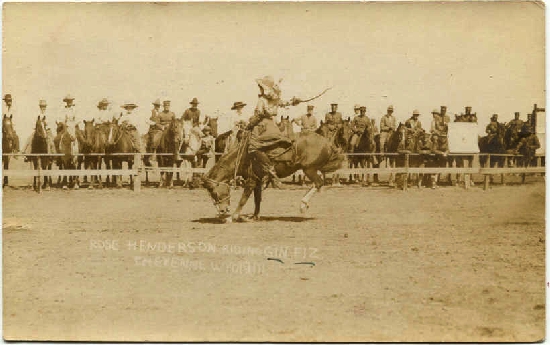
Prairie Rose Henderson on Gin Fiz, 1912
Prairie Rose Henderson first entered the 1910 contest and was a member of the company for
the Irwin Brothers Wild West Show. [Writer's note, a history of Rodeo contained in the
program for the 1936 Boston Garden Rodeo, discussed on a subsequent page, indicates that
Praire Rose appeared at the 1901 Frontier Day show.]
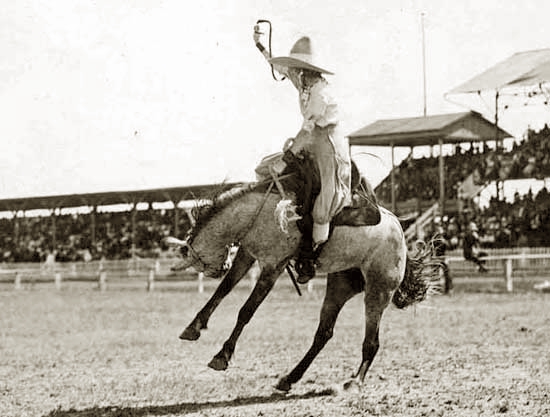
Prairie Rose Henderson, Frontier Days. Photo by Ralph Doubleday.
Prairie Rose also
participated in 1911 and 1917. She remained active until the 1930's. In 1932, her then
husband Charles Coleman was arrested. On his release from jail, she had vanished from
their Fremont County home. Seven years later her remains were found and identified by Coleman and her brother from
a ring and other articles. From the articles found with her remains, she apparently froze to death in a
snow storm. Other husband and wife entrants included the Danks, the Strouds,
the Hastings, the Roaches and "Skeeter Bill" Robbins and his wife Dorothy Morrell Robbins. The
Robbins are discussed on the next page. As noted
on a subsequent page, Clayton Danks was the 1904 Steer Roping Champion and the
1907 Saddle Bronc Champion. Mrs. Danks won the 1908 Denver Post Ladies' Relay.
Indeed, the prize won by Mrs. Danks was greater than than of the men.
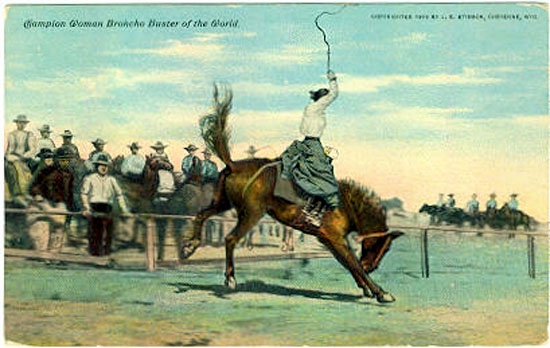
Goldie St. Clair on Red Sandy, photo by J. E. Stimson, 1909
Compare the above postcard with the next, two different postcards made by
two different photographers within moments of each other.
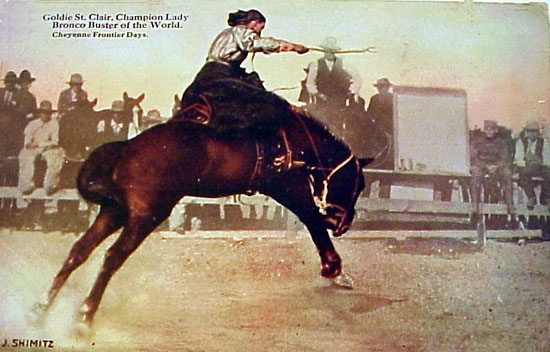
Goldie St. Clair on Red Sandy, tinted photo by J. Shimitz, 1909.
Observe the quirt. Over the years the rules for Rodeos have changed. Beginning about 1929 uniform rules for the
various contests began to be developed. Thus, the writer of a 1936 rodeo program observed:
Rodeo rules have been changed for the better, making each contest faster. Horses,
instead of being saddled in the open and thereby wasting much of their strength before
the rider gets aboard, are now saddled in the chutes. Nine or ten seconds on a fresh
bronk that has been "poured out" of a chute, is equal to a finish ride on a bronk
that has been saddled in the open.
There is no more mishandling of animals at a Rodeo. All the "breaks" today are
in favor of the horse or the steer, as against the contestant. Spurs are taped and
no quiting of horses is permitted. Any cowboy found guilty of cruelty to an
an animal is barred from the Rodeo.
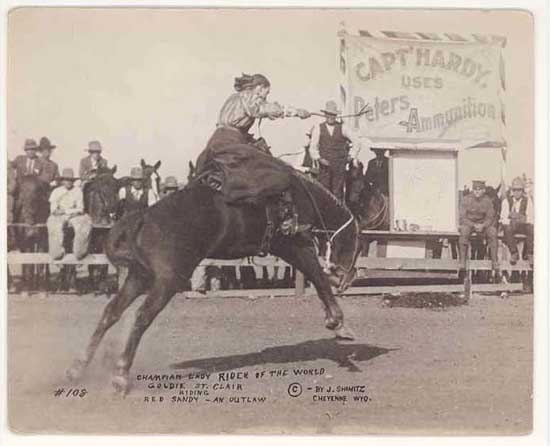
Goldie St. Clair on Red Sandy, real photo by J. Shimitz, 1909.
The reference on the sign is to Capt. A. H. Hardy, a well-known trick shooter.
Captain Hardy toured the country giving demonstrations of his prowness with a
Model 1897 lever action Marlin .22 as well as with revolvers. The reference to
Peters is to the Peters Cartidge and Ammunition Company.
Goldie St. Clair with her husband, Barny St. Clair, was a performer with Miller Bros. 101 and won both the 1909 and 1910 Women's
Bronco Riding Contests. In the 1910 Contest former president Roosevelt expressed concern
that she might be hurt. The following year, in Philadelphia, a bronc named
Roan Mare fell on her causing life threatening injuries. Soon St. Clair was back performing including at the
1916 State Fair in Douglas.
Mu;sic this page, "Loyal Canadians March" dedicated by Horse Creek Cowboy to the memory of
World Champion Bulldogger, Adelbert "Dell" Blancett
Next page, Frontier Days continued.
|